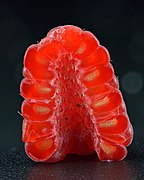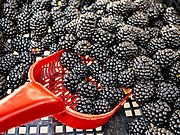Blackberry
| Blackberry | |
|---|---|
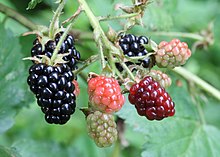
| |
| Ripe, ripening, and unripe Allegheny blackberries (Rubus allegheniensis) | |

| |
| Blackberry flower,Rubus fruticosusspecies aggregate | |
| Scientific classification | |
| Kingdom: | Plantae |
| Clade: | Tracheophytes |
| Clade: | Angiosperms |
| Clade: | Eudicots |
| Clade: | Rosids |
| Order: | Rosales |
| Family: | Rosaceae |
| Genus: | Rubus |
| Subgenus: | Rubussubg.Rubus |
| Species | |
And hundreds moremicrospecies | |
| Synonyms | |
|
Rubussubg.Eubatus | |
Theblackberryis an edible fruit produced by manyspeciesin the genusRubusin thefamilyRosaceae,hybrids among these species within the subgenusRubus,and hybrids between the subgeneraRubusandIdaeobatus.The taxonomy of blackberries has historically been confused because ofhybridizationandapomixis,so that species have often been grouped together and calledspecies aggregates.For example, the entire subgenusRubushas been called theRubus fruticosusaggregate, although the speciesR. fruticosusis considered a synonym ofR. plicatus.[1]
Blackberry fruit production is abundant with annual volumes of 20,000 pounds (9,100 kg) per 1 acre (0.40 ha) possible, making this plant commercially attractive.[2]
Rubus armeniacus( "Himalayan" blackberry) is considered anoxious weedandinvasive speciesin many regions of thePacific Northwestof Canada and the United States, where it grows out of control in urban and suburban parks and woodlands.[3][4]
Description[edit]
What distinguishes the blackberry from itsraspberryrelatives is whether or not the torus (receptacleor stem) "picks with" (i.e., stays with) the fruit. When picking a blackberry fruit, the torus stays with the fruit. With a raspberry, the torus remains on the plant, leaving a hollow core in the raspberry fruit.[5]
-
Halved blackberry with present torus
-
Halved raspberry with absent torus, for contrast
-
Wild blackberries picked in May in Texas
-
Blackberries fromSrem,Serbia
The termbramble,a word referring to any impenetrablethicket,has in some circles traditionally been applied specifically to the blackberry or its products,[6]though in the United States it applies to all members of the genusRubus.In the western US, the termcaneberryis used to refer to blackberries and raspberries as a group rather than the term bramble.Briarorbriermay be used to refer to the dense vines of the plant, though this name is used for other thorny thickets (such asSmilax) as well.[7]
The usually black fruit is not aberryin thebotanicalsense, as it is termed botanically as anaggregate fruit,composed of smalldrupelets.It is a widespread and well-known group of over 375 species, many of which are closely relatedapomictic microspeciesnativethroughout Europe, northwestern Africa,temperatewestern and central Asia and North and South America.[8]
Plants[edit]
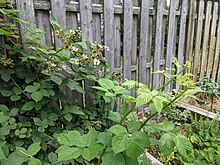
Blackberries areperennialplants bearingbiennialstems (calledcanes) from their roots.[9]
In its first year, a new stem, theprimocane,reaches a full length of about 3–6 metres (9.8–19.7 feet) trailing on the ground and bearing largepalmate compoundleaveswith 5–7 new leaves; it does not produce any flowers.[9]In its second year, the cane is afloricanewith a non-growing stem.[9]The lateral buds open to produce flowering laterals.[9]First- and second-year shoots produce short-curved, sharpthorns.[9]Thornless cultivars have been developed during the early 21st century.[9][10]
Unmanaged plants tend to aggregate in a dense tangle of stems and branches,[4]which can be controlled in gardens or farms usingtrellises.[2][9]Blackberry shrubs can tolerate poorsoils,spreading readily in wasteland, ditches, and roadsides.[4][8][11]
Theflowersbloom in late spring and early summer on the tips of branches.[8][9]Each flower is about2–3 centimetres (3⁄4–1+1⁄4inches) in diameter, with five white-pinkpetals.[8][9]The fruit only develops around ovules fertilized by the malegametefrom a pollen grain.[citation needed]The most likely cause of undeveloped ovules is inadequatepollinatorvisits.[12]Incomplete drupelet development can signal infection withraspberry bushy dwarf virus.[citation needed]

Genetics[edit]
Thelocicontrolling the primocane fruiting was mapped in the F Locus, on LG7, whereas thorns/thornlessness was mapped on LG4.[13]Better understanding of the genetics is useful for genetic screening of cross-breds, and for genetic engineering purposes.[citation needed]
Ecology[edit]

Blackberry leaves are food for certaincaterpillars;some grazing mammals, especially deer, are also very fond of the leaves. Caterpillars of theconcealer mothAlabonia geoffrellahave been found feeding inside dead blackberry shoots. When mature, the berries are eaten and their seeds dispersed by mammals, such as the red fox, American black bear and the Eurasian badger, as well as by small birds.[14]

Blackberries grow wild throughout most of Europe. They are an important element in the ecology of many countries, and harvesting the berries is a common pastime. However, their vigorous growth and tendency to grow unchecked if not managed correctly means that the plants are also considered a weed, sending downroots from branches that touch the ground,and sending upsuckersfrom the roots. In some parts of the world, such as in Australia, Chile, New Zealand, and thePacific Northwestof North America, some blackberry species, particularlyRubus armeniacus(Himalayan blackberry) andRubus laciniatus(evergreen blackberry), arenaturalizedand considered aninvasive speciesand anoxious weed.[3][4][8]
Blackberry fruits are red when unripe, leading to an old expression that "blackberries are red when they're green".[15][16]
Cultivation[edit]
Worldwide, Mexico is the leading producer of blackberries, with nearly the entire crop being produced for export into the off-season fresh markets in North America and Europe.[17]Until 2018, the Mexican market was almost entirely based on the cultivar 'Tupy' (often spelled 'Tupi', but the EMBRAPA program in Brazil from which it was released prefers the 'Tupy' spelling), but Tupy fell out of favor in some Mexican growing regions.[18]In the US,Oregonis the leading commercial blackberry producer, producing 19,300,000 kilograms (42,600,000 pounds) on 2,500 hectares (6,300 acres) in 2017.[19][20]
Numerouscultivarshave been selected for commercial and amateur cultivation in Europe and the United States.[2][10][21]Since the many species formhybridseasily, there are numerous cultivars with more than one species in their ancestry.[10]
History[edit]
Modernhybridizationandcultivardevelopment took place mostly in the US. In 1880, a hybrid blackberry-raspberry named theloganberrywas developed inSanta Cruz, California,by an American judge andhorticulturalist,James Harvey Logan.One of the first thornless varieties was developed in 1921, but the berries lost much of their flavor. Common thornless cultivars developed from the 1990s to the early 21st century by theUS Department of Agricultureenabled efficient machine-harvesting, higher yields, larger and firmer fruit, and improved flavor, including theTriple Crown,[22][23]Black Diamond,Black Pearl,andNightfall,amarionberry.[10]
Hybrids[edit]

'Marion' (marketed as "marionberry") is an important cultivar that was selected from seedlings from a cross between 'Chehalem' and 'Olallie' (commonly called"Olallieberry") berries.[24]'Olallie' in turn is a cross betweenloganberryandyoungberry.'Marion', 'Chehalem' and 'Olallie' are just three of many trailing blackberry cultivars developed by theUnited States Department of AgricultureAgricultural Research Service(USDA-ARS) blackberry breeding program atOregon State UniversityinCorvallis, Oregon.[10]
The most recent cultivars released from this program are the thornless cultivars 'Black Diamond', 'Black Pearl', and 'Nightfall' as well as the early-ripening 'Obsidian' and 'Metolius'. 'Black Diamond' is now the leading cultivar being planted in the Pacific Northwest. Some of the other cultivars from this program are 'Newberry', 'Waldo', 'Siskiyou', 'Black Butte', 'Kotata', 'Pacific', and 'Cascade'.[10]
Varieties with good commercial characteristics developed inArkansasare grown in nurseries inOklahoma.[2]Such blackberries are easy to grow, and may produce fruit for a decade or more.[2]These varieties have diverse flavors varying from sweet to tart.[2]
Trailing[edit]
Trailing blackberries are vigorous and crown-forming, require atrellisfor support, and are less cold-hardy than the erect or semi-erect blackberries. In addition to thePacific Northwest,these types do well in similar climates, such as the United Kingdom, New Zealand, Chile, and theMediterranean countries.[citation needed]
Thornless[edit]
Semi-erect, prickle-free blackberries were first developed at theJohn Innes CentreinNorwich,UK, and subsequently by the USDA-ARS inBeltsville, Maryland.These are crown forming and very vigorous and need a trellis for support. Cultivars include 'Black Satin', 'Chester Thornless', 'Dirksen Thornless', 'Hull Thornless', 'Loch Maree', 'Loch Ness', 'Loch Tay', 'Merton Thornless', 'Smoothstem', and 'Triple Crown'.[25]'Loch Ness' and 'Loch Tay' have gained theRHS'sAward of Garden Merit.[26]The cultivar 'Cacanska Bestrna' (also called 'Cacak Thornless') has been developed in Serbia and has been planted on many thousands of hectares there.
Erect[edit]
TheUniversity of Arkansashas developed cultivars of erect blackberries. These types are less vigorous than the semi-erect types and produce new canes from root initials (therefore they spread underground like raspberries). There are prickly and prickle-free cultivars from this program, including 'Navaho', 'Ouachita', 'Cherokee', 'Apache', 'Arapaho', and 'Kiowa'.[27][28]They are also responsible for developing the primocane fruiting blackberries such as 'Prime-Jan' and 'Prime-Jim'.[27]
Primocane[edit]
In raspberries, these types are called primocane fruiting, fall fruiting, or everbearing. 'Prime-Jim' and 'Prime-Jan' were released in 2004 by theUniversity of Arkansasand are the first cultivars of primocane fruiting blackberry.[29]They grow much like the other erect cultivars described above; however, the canes that emerge in the spring will flower in midsummer and fruit in late summer or fall. The fall crop has its highest quality when it ripens in cool mild climate such as in California or the Pacific Northwest.[30]
'Illini Hardy', a semi-erect prickly cultivar introduced by theUniversity of Illinois,is cane hardy in zone 5, where blackberry production has traditionally been problematic, since canes often failed to survive the winter.[citation needed]
Mexico and Chile[edit]
Blackberry production in Mexico expanded considerably in the early 21st century.[17][20]In 2017, Mexico had 97% of themarket sharefor fresh blackberries imported into the United States, while Chile had 61% of the market share for American imports of frozen blackberries.[20]
While once based on the cultivar 'Brazos', an old erect blackberry cultivar developed in Texas in 1959, the Mexican industry is now dominated by the Brazilian 'Tupy' released in the 1990s. The 'Tupy' has the erect blackberry 'Comanche', and a "wild Uruguayan blackberry" as parents.[31]Since there are no native blackberries in Uruguay, the suspicion is that the widely grown 'Boysenberry' is the male parent. To produce these blackberries in regions of Mexico where there is no winter chilling to stimulate flower bud development, chemical defoliation and application of growth regulators are used to bring the plants into bloom.[citation needed]
Diseases and pests[edit]
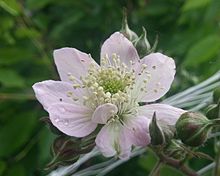
Because blackberries belong to the same genus as raspberries,[32]they share the same diseases, includinganthracnose,which can cause the berry to have uneven ripening. Sap flow may also be slowed.[33][34]They also share the same remedies, including the Bordeaux mixture,[35]a combination of lime, water andcopper(II) sulfate.[36]The rows between blackberry plants must be free of weeds, blackberry suckers and grasses, which may lead to pests or diseases.[37]Fruit growers are selective when planting blackberry bushes because wild blackberries may be infected,[37]and gardeners are recommended to purchase only certified disease-free plants.[38]
The spotted-wing drosophila,Drosophila suzukii,is a serious pest of blackberries.[39]Unlike its vinegar fly relatives, which are primarily attracted to rotting or fermented fruit,D. suzukiiattacks fresh, ripe fruit by laying eggs under the soft skin. The larvae hatch and grow in the fruit, destroying the fruit's commercial value.[39]
Another pest isAmphorophora rubi,known as the blackberry aphid, which eats not just blackberries but raspberries as well.[40][41][42]
Byturus tomentosus(raspberry beetle),Lampronia corticella(raspberry moth) andAnthonomus rubi(strawberry blossom weevil) are also known to infest blackberries.[43]
 Close-up view of a blackberry | |
| Nutritional value per 100 g (3.5 oz) | |
|---|---|
| Energy | 180 kJ (43 kcal) |
9.61 g | |
| Sugars | 4.88 g |
| Dietary fiber | 5.3 g |
0.49 g | |
1.39 g | |
| Vitamins | Quantity %DV† |
| Vitamin A | 214 IU |
| Thiamine (B1) | 2% 0.020 mg |
| Riboflavin (B2) | 2% 0.026 mg |
| Niacin (B3) | 4% 0.646 mg |
| Vitamin B6 | 2% 0.030 mg |
| Folate (B9) | 6% 25 μg |
| Vitamin C | 23% 21.0 mg |
| Vitamin E | 8% 1.17 mg |
| Vitamin K | 17% 19.8 μg |
| Minerals | Quantity %DV† |
| Calcium | 2% 29 mg |
| Iron | 3% 0.62 mg |
| Magnesium | 5% 20 mg |
| Manganese | 28% 0.646 mg |
| Phosphorus | 2% 22 mg |
| Potassium | 5% 162 mg |
| Sodium | 0% 1 mg |
| Zinc | 5% 0.53 mg |
| Other constituents | Quantity |
| Water | 88 g |
| †Percentages estimated usingUS recommendationsfor adults,[44]except for potassium, which is estimated based on expert recommendation fromthe National Academies.[45] | |
Uses[edit]
Nutrients[edit]
Raw blackberries are 88% water, 10%carbohydrates,1%protein,and 0.5% fat (table). In a 100 grams (3.5 oz) reference amount, raw cultivated blackberries supply 43caloriesand rich contents (20% or more of theDaily Value(DV) ofdietary fiber,manganese(31% DV),vitamin C(25% DV), andvitamin K(19% DV) (table).
Seed composition[edit]
Blackberries contain numerous large seeds that are not always preferred by consumers. The seeds contain oil rich inOmega -3(Alpha -linolenic acid) and Omega -6 (linoleic acid) fats as well asprotein,dietary fiber,carotenoids,ellagitannins,andellagic acid.[46]
Culinary use[edit]
The ripe fruit is commonly used in desserts, jams, jelly, wine andliqueurs.It may be mixed with other berries and fruits for pies andcrumbles.[47]
Phytochemical research[edit]
Blackberries contain numerousphytochemicalsincludingpolyphenols,flavonoids,anthocyanins,salicylic acid,ellagic acid,andfiber.[48][49]Anthocyanins in blackberries are responsible for their rich dark color. One report placed blackberries at the top of more than 1,000 polyphenol-rich foods consumed in the United States,[50]but this concept of a health benefit from consuming dark-colored foods like blackberries remains scientifically unverified and not accepted forhealth claimson food labels.[51]
Historical uses[edit]
One of the earliest known instances of blackberry consumption comes from the remains of theHaraldskær Woman,the naturally preservedbog bodyof a Danish woman dating from approximately 2,500 years ago. Forensic evidence found blackberries in her stomach contents, among other foods. The use of blackberries to make wines andcordialswas documented in theLondon Pharmacopoeiain 1696.[22]In the culinary world, blackberries have a long history of use alongside other fruits to make pies, jellies and jams.[22]
Blackberry plants were used fortraditional medicineby Greeks, other European peoples, and aboriginal Americans.[22]A 1771 document described brewing blackberry leaves, stem, and bark forstomach ulcers.[22]
Blackberry fruit, leaves, and stems have been used to dye fabrics and hair. Native Americans have even been known to use the stems to make rope. The shrubs have also been used for barriers around buildings, crops and livestock. The wild plants have sharp, thick prickles, which offered some protection against enemies and large animals.[22]
In culture[edit]
Folklore in the United Kingdom and Ireland tells that blackberries should not be picked afterOld Michaelmas Day(11 October) as thedevil(or aPúca) has made them unfit to eat by stepping, spitting or fouling on them.[52]There is some value in this legend as autumn's wetter and cooler weather often allows the fruit to become infected by variousmoldssuch asBotryotiniawhich give the fruit an unpleasant look and may be toxic.[53]According to some traditions, a blackberry's deep purple color represents Jesus' blood and thecrown of thornswas made of brambles,[54][55]although other thorny plants, such asCrataegus(hawthorn) andEuphorbia milii(crown of thorns plant), have been proposed as the material for the crown.[56][57]
See also[edit]
- Rubus plicatus,a common European species of blackberry
- Elmleaf blackberry,another common European species of blackberry
- Pacific blackberry,a North American species of blackberry
- Rubus fruticosus,an ambiguous name used byCarl Linnaeusthat applied to multiple species
- Mulberry,similar fruit appearance, but a tree rather than abramble
- Redberry mite,a common pest of North American blackberry crops
References[edit]
- ^Jarvis, C.E. (1992). "Seventy-Two Proposals for the Conservation of Types of Selected Linnaean Generic Names, the Report of Subcommittee 3C on the Lectotypification of Linnaean Generic Names".Taxon.41(3): 552–583.doi:10.2307/1222833.JSTOR1222833.
- ^abcdefCarroll B (February 2017)."Commercial Blackberry Production".Division of Agricultural Sciences and Natural Resources, Oklahoma State University.Retrieved10 April2024.
- ^ab"Himalayan blackberry".Invasive Species Council of BC. 2021.Retrieved13 August2021.
- ^abcd"Himalayan blackberry: identification and control".King County, Washington: Noxious Weed Control Program. 16 February 2021.Retrieved13 August2021.
- ^Gina Fernandez; Elena Garcia; David Lockwood."Fruit development".North Carolina State University, Cooperative Extension.Retrieved9 August2018.
- ^Shorter Oxford English Dictionary(6th ed.). Oxford, UK: Oxford University Press. 2007. p. 3804.ISBN978-0199206872.
- ^Harrison, Les."Wicked weeds: A tangled tale of thorny smilax".Tallahassee Democrat.Retrieved26 May2024.
- ^abcdeHuxley, Anthony (1992).Dictionary of gardening.London New York: Macmillan Press Stockton Press.ISBN978-0-333-47494-5.OCLC25202760.
- ^abcdefghiKrewer, Gerard; Fonseca, Marco; Brannen, Phil; Horton, Dan (2004)."Home Garden:Raspberries, Blackberries"(PDF).Cooperative Extension Service/The University of Georgia College of Agricultural and Environmental Sciences. Archived fromthe original(PDF)on 26 November 2013.
- ^abcdef"Thornless processing blackberry cultivars".US Department of Agriculture. 26 June 2018. Archived fromthe originalon 21 June 2019.Retrieved21 June2019.
- ^Blamey, Marjorie (1989).The illustrated flora of Britain and northern Europe.Hodder & Stoughton.ISBN978-0-340-40170-5.OCLC41355268.
- ^Green, David L."Blackberry Pollination Images".The Pollination Home Page.
- ^Castro, P.; Stafne, E. T.; Clark, J. R.; Lewers, K. S. (16 July 2013). "Genetic map of the primocane-fruiting and thornless traits of tetraploid blackberry".Theoretical and Applied Genetics.126(10). Springer Nature: 2521–2532.doi:10.1007/s00122-013-2152-3.PMID23856741.S2CID16250883.
- ^Fedriani, José M.; Delibes, Miguel (2009). "Functional diversity in fruit-frugivore interactions: a field experiment with Mediterranean mammals".Ecography.32(6): 983–992.doi:10.1111/j.1600-0587.2009.05925.x.hdl:10261/50153.JSTOR20696310.
- ^Palmatier, Robert Allen (30 August 2000).Food: A Dictionary of Literal and Nonliteral Terms.Santa Barbara, Calif.:Greenwood.p.26.ISBN9780313314360.Retrieved17 March2018.
- ^Marrone, Teresa (2011).Indiana, Kentucky, and Ohio wild berries & fruits.Teresa Marrone. p. 272.
- ^abPerry, Mark J. (7 October 2017)."Mexico's berry bounty fuels trade dispute – U.S. consumers dismiss U.S. berry farmers' complaints as 'sour berries'".American Enterprise Institute, Washington, DC.Retrieved21 June2019.
- ^"Tupy blackberry, at risk due to lack of interest in its production".FreshPlaza. 10 May 2018. Archived fromthe originalon 21 June 2019.Retrieved21 June2019.
- ^"Press Release June 27, 2018"(PDF).United States Department of Agriculture, National Agricultural Statistics Service, Northwest Regional Field Office. Archived fromthe original(PDF)on 20 February 2019.Retrieved19 February2019.
- ^abc"Blackberries".US Agriculture Marketing Resource Center. 1 February 2019.Retrieved21 June2019.
- ^"Evergreen blackberry, Oregon Raspberry and Blackberry Commission".Oregon-Berries.Archived fromthe originalon 4 October 2008.Retrieved13 June2017.
- ^abcdefHarding, Deborah."The History of the Blackberry Fruit".gardenguides.Garden Guides, Leaf Group Ltd.Retrieved20 June2019.
- ^"'Triple Crown' thornless blackberry ".US Department of Agriculture. 2 February 1998.Retrieved21 June2019.
- ^"Marionberry, Oregon Raspberry and Blackberry Commission".Oregon-Berries.Archived fromthe originalon 19 September 2008.Retrieved13 June2017.
- ^Folta, Kevin M.;Kole, Chittaranjan (2011).Genetics, Genomics and Breeding of Berries.CRC Press. pp. 69–71.ISBN978-1578087075.
- ^"AGM Plants © RHS – CROPS BLACKBERRIES"(PDF).Royal Horticultural Society. November 2018. Archived fromthe original(PDF)on 5 August 2018.Retrieved21 November2019.
- ^abFolta, Kevin M.;Kole, Chittaranjan (2011).Genetics, Genomics and Breeding of Berries.CRC Press. p. 71.ISBN978-1578087075.
- ^Fernandez, Gina; Ballington, James."Growing blackberries in North Carolina".North Carolina Cooperative Extension Service, North Carolina University Press. p. 2. Archived fromthe originalon 8 January 2016.Retrieved9 October2015.
- ^Vincent, Christopher I. (2008).Yield Dynamics of Primocane-fruiting Blackberries Under High-tunnels and Ambient Conditions, Including Plant Growth Unit Estimations and Arthropod Pest Considerations.p. 2.ISBN978-0549964759.Retrieved12 November2012.[permanent dead link]
- ^Clark, J.R.; Strick, B.C.; Thompson, E.; Finn, C.E. (2012). "Progress and challenges in primocane-fruiting blackberry breeding and cultural management".Acta Horticulturae.926(926): 387–392.doi:10.17660/ActaHortic.2012.926.54.
- ^Antunes, L.E.C.; Rassieira, M.C.B. (2004). "Aspectos Técnicos da Cultura da Amora-Preta".Pelotas: Embrapa Clima Temperado(in Portuguese).ISSN1516-8840.
- ^Bradley, Fern Marshall; Ellis, Barbara W.; Martin, Deborah L. (2010).The Organic Gardener's Handbook of Natural Pest and Disease Control: A Complete Guide to Maintaining a Healthy Garden and Yard the Earth-Friendly Way.Rodale, Inc.p. 51.ISBN978-1605296777.Retrieved12 November2012.
- ^"Growing Raspberries & Blackberries"(PDF).cals.uidaho.edu. p. 29.Retrieved13 November2012.
- ^Controlling diseases of raspberries and blackberries.United States. Science and Education Administration. 1980. p. 5.Retrieved12 November2012.
- ^Waite, Merton Benway (1906).Fungicides and their use in preventing diseases of fruits.U.S. Dept. of Agriculture. p.243.Retrieved12 November2012.
blackberry disease.
- ^"Bordeaux Mixture".ucdavis.edu. June 2010.Retrieved13 November2012.
- ^abEnsminger, Audrey H. (1994).Foods and Nutrition Encyclopedia: A-H.CRC Press. p. 215.ISBN9780849389818.Retrieved12 November2012.
- ^Shrock, Denny (2004).Home Gardener's Problem Solver: Symptoms and Solutions for More Than 1,500 Garden Pests and Plant Ailments.Meredith Books. p. 352.ISBN978-0897215046.Retrieved12 November2012.
- ^abWalsh, Doug."Spotted Wing Drosophila Could Pose Threat For Washington Fruit Growers"(PDF).sanjuan.WSU.edu. Archived fromthe original(PDF)on 6 August 2010.Retrieved12 November2012.
- ^Hill, Dennis S. (1987).Agricultural Insect Pests of Temperate Regions and Their Control.Cambridge University Press.p. 228.ISBN978-0521240130.Retrieved12 November2012.
- ^The Review of Applied Entomology: Agricultural, Volume 18.CAB International.1931. p. 539.Retrieved12 November2012.
- ^R. L. Blackman, V. F. Eastop and M. Hills (1977).Morphological and cytological separation of Amphorophora Buckton (Homoptera: Aphididae) feeding on European raspberry and blackberry ( Rubus spp.).Bulletin of Entomological Research, 67, pp 285–296doi:10.1017/S000748530001110X
- ^Squire, David (2007).The Garden Pest & Diseases Specialist: The Essential Guide to Identifying and Controlling Pests and Diseases of Ornamentals, Vegetables and Fruits.New Holland Publishers.p. 39.ISBN978-1845374853.Retrieved12 November2012.[permanent dead link]
- ^United States Food and Drug Administration(2024)."Daily Value on the Nutrition and Supplement Facts Labels".FDA.Archivedfrom the original on 27 March 2024.Retrieved28 March2024.
- ^National Academies of Sciences, Engineering, and Medicine; Health and Medicine Division; Food and Nutrition Board; Committee to Review the Dietary Reference Intakes for Sodium and Potassium (2019). Oria, Maria; Harrison, Meghan; Stallings, Virginia A. (eds.).Dietary Reference Intakes for Sodium and Potassium.The National Academies Collection: Reports funded by National Institutes of Health. Washington, DC: National Academies Press (US).ISBN978-0-309-48834-1.PMID30844154.Archivedfrom the original on 9 May 2024.Retrieved21 June2024.
- ^Bushman BS, Phillips B, Isbell T, Ou B, Crane JM, Knapp SJ (December 2004). "Chemical composition of caneberry (Rubus spp.) seeds and oils and their antioxidant potential".Journal of Agricultural and Food Chemistry.52(26): 7982–7.doi:10.1021/jf049149a.PMID15612785.S2CID32100735.
- ^Dowling, Tim (28 August 2023)."Berry good! 17 wonderful ways with blackberries – from crumbles and cakes to mousses and muffins".The Guardian.ISSN0261-3077.Retrieved26 May2024.
- ^"Nutrition facts for raw blackberries".Nutritiondata.Conde Nast. 2012.
- ^Sellappan, S.; Akoh, C. C.; Krewer, G. (2002). "Phenolic compounds and antioxidant capacity of Georgia-grown blueberries and blackberries".Journal of Agricultural and Food Chemistry.50(8): 2432–2438.doi:10.1021/jf011097r.PMID11929309.
- ^Halvorsen BL, Carlsen MH, Phillips KM, et al. (July 2006)."Content of redox-active compounds (ie, antioxidants) in foods consumed in the United States".The American Journal of Clinical Nutrition.84(1): 95–135.doi:10.1093/ajcn/84.1.95.PMID16825686.
- ^Gross PM (1 March 2009),New Roles for Polyphenols. A 3-Part report on Current Regulations & the State of Science,Nutraceuticals World
- ^"Michaelmas Traditions".BlackCountryBugle.co.uk.7 October 2010. Archived fromthe originalon 30 March 2012.Retrieved13 June2017.
- ^"Michaelmas, 29th September, and the customs and traditions associated with Michaelmas Day".Historic-UK.Retrieved13 June2017.
- ^Watts, D.C. (2007).Dictionary of Plant Lore(Rev. ed.). Oxford: Academic. p. 36.ISBN978-0-12-374086-1.
- ^Alexander, Courtney."Berries As Symbols and in Folklore"(PDF).Cornell Fruit.Retrieved11 August2015.
- ^Hawthorn.Encyclopædia Britannica: A Dictionary of Arts, Sciences, and General Literature, Volume 11; R.S. Peale. 1891.
- ^Ombrello T (2015)."Crown of thorns".Union County College, Department of Biology, Cranford, NJ. Archived fromthe originalon 17 September 2009.Retrieved18 August2015.
Further reading[edit]
- Allen, D. E.; Hackney, P. (2010). "Further fieldwork on the brambles (Rubus fruticosusL. agg.) of North-east Ireland ".Irish Naturalists' Journal.31:18–22.
External links[edit]
 Media related toBlackberryat Wikimedia Commons
Media related toBlackberryat Wikimedia Commons


